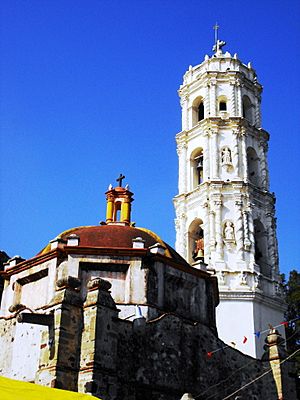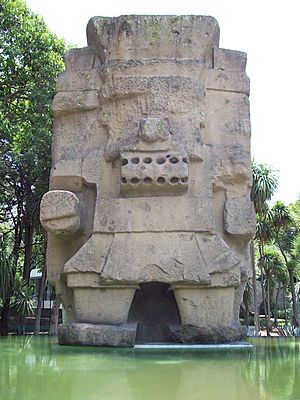Coatlinchan facts for kids
Coatlinchan is a town in the Mexican state of Mexico. Its full name is San Miguel Coatlinchán. The name comes from the Nahuatl language. It means 'In the home of the snakes'.
This town is famous for being the original home of a giant stone statue. This statue is known as the Tláloc monolith. Today, you can see it at the National Museum of Anthropology in Mexico City.
Contents
Where is Coatlinchan Located?
San Miguel Coatlinchán is in the southern part of the Texcoco area. It is about 5 kilometers (3 miles) south of the city of Texcoco de Mora. The town sits between the Valley of Mexico and the Sierra Nevada mountains.
It is about 2,300 meters (7,546 feet) above sea level. The main road connecting it to other places is Federal Highway 136. This road used to be called the Mexico-Texcoco Highway. Other nearby towns include San Bernardino and Santiago Cuautlalpan.
How Many People Live in Coatlinchan?
In 2010, a study counted the people living in San Miguel Coatlinchán. There were 22,619 people in total. About 11,089 were men and 11,530 were women. This makes Coatlinchán the second-largest town in the Texcoco area.
Coatlinchan's Ancient History
Coatlinchán has a very old history. It was first settled by people called Chichimec. Later, another group called the Acolhuas took over the area.
Coatlinchán became the main city for the Acolhuas. But around the year 1337, the main city was moved to Tetzcuco. Today, Tetzcuco is known as Texcoco.
The Giant Tláloc Statue
The people of Coatlinchán were very good at working with stone. They created a huge stone sculpture. This sculpture later became famous. It was found in a place called the Barranca of Santa Clara.
Today, this giant statue is known as the Tláloc monolith. Tláloc was the god of water and rain for ancient Mesoamerican cultures. Some experts believe the statue might be Chalchiuhtlicue. She was Tláloc's sister or wife, and also a water deity.
Discovery of the Monolith
The statue was buried for a long time after the Spanish conquest. In the mid-1800s, a farmer found part of it while looking for wood. Later, the whole statue was uncovered.
In 1889, a painter named José María Velasco painted the monolith. He thought it was Chalchiuhtlicue. In 1903, an archaeologist named Leopoldo Batres said it was Tláloc.
However, the local people always called it the "Piedra de los Tecomates." This means "Stone of the Gourds." It has round holes in its center that look like gourds.
Local Beliefs and the Statue
The people of Coatlinchán believed the statue had special powers. They thought it could bring rain if the holes were wet. They also thought the water collected in the holes had healing powers.
People would offer gifts to the statue. They would ask for enough rain and good harvests. The monument also became a popular place for visitors.
Moving the Statue to Mexico City
In 1963, the Mexican government wanted to move the statue. The president at the time, Adolfo López Mateos, was building the National Museum of Anthropology. He wanted the monolith to be at the museum's entrance.
The government asked the community for the statue. In May 1963, the town agreed to donate it. In return, the government promised several public works. These included paving a highway junction and building a primary school. They also promised a health center and water wells.
Community Protests and the Transfer
The work to move the statue took a long time. During this time, many people in Coatlinchán started to oppose the move. They worried that losing the statue would hurt their tourism and local economy. They also feared it would affect the rains.
On February 23, 1964, the people protested strongly. They damaged the structures built to move the statue. They also deflated the tires of the trucks. The government put off the move for a while.
But on April 16, 1964, the Mexican Army arrived. They took control of the town to prevent more protests. The giant statue, weighing 168 tons, was then moved on a special trailer.
As the statue passed, the villagers watched. Then, there was a huge, unexpected downpour of rain. It rained all through the night. Many people believed this was a sign from the gods.
See also
 In Spanish: San Miguel Coatlinchán para niños
In Spanish: San Miguel Coatlinchán para niños



